Our Official State Tree
By Gretchen Spencer, former Fairfax Master Gardener
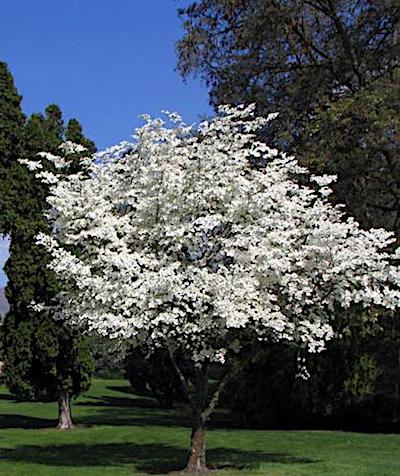 Considered by many to be the most beautiful spring flowering tree, the flowering dogwood generates year-round interest from its elegant white spring blossoms, to its brilliant fall foliage, glossy red fruit clusters and handsome blocky dark-gray bark. In the winter, its horizontal branching structure and small onion-dome buds stand out prominently.
Considered by many to be the most beautiful spring flowering tree, the flowering dogwood generates year-round interest from its elegant white spring blossoms, to its brilliant fall foliage, glossy red fruit clusters and handsome blocky dark-gray bark. In the winter, its horizontal branching structure and small onion-dome buds stand out prominently.
Both the Latin name for the flowering dogwood, Cornus florida, and its common name, dogwood, provide some interesting clues to this popular tree’s attributes. The word Cornus means horn and refers to its hard wood. Florida from the Latin flos means flower and refers to its showy blossoms. The derivation of dogwood relates to colonial times when the hard wood was used to make skewers or “dogs.” The hard wood has also been used to make weaver’s shuttles, golf club heads, spools, jewelry boxes and chisel and maul handles.
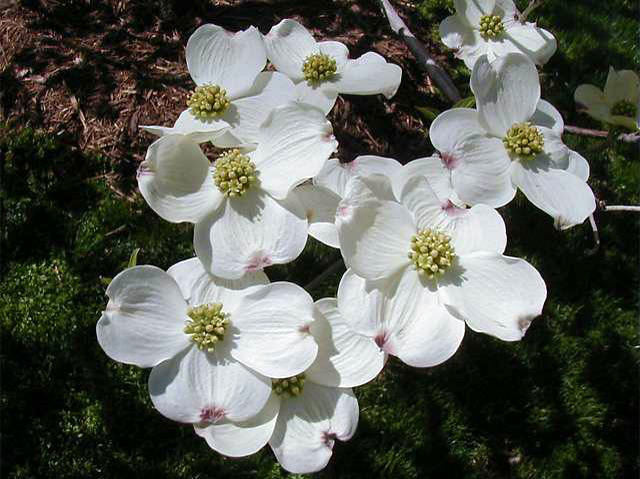 Cornus florida is native to eastern North America and was cultivated from the wild in the 1730’s. Both George Washington and Thomas Jefferson planted them on their properties. A small tree, it typically grows between 15 and 30 feet tall (4 to 10 m) and wide. Its low branches spread horizontally. The dark green, oval leaves grow 3 to 6 inches (7 to 15 cm) long. They provide beautiful fall color as they turn red to reddish purple in the late summer. The true dogwood flowers are tiny yellowish green clusters surrounded by four, large white petal-like bracts (actually modified leaves) that form the brilliant white blossoms. Pink or red dogwoods are rare in nature as this trait is recessive; pink or red bracts only occur when the red gene is inherited from both parent trees.
Cornus florida is native to eastern North America and was cultivated from the wild in the 1730’s. Both George Washington and Thomas Jefferson planted them on their properties. A small tree, it typically grows between 15 and 30 feet tall (4 to 10 m) and wide. Its low branches spread horizontally. The dark green, oval leaves grow 3 to 6 inches (7 to 15 cm) long. They provide beautiful fall color as they turn red to reddish purple in the late summer. The true dogwood flowers are tiny yellowish green clusters surrounded by four, large white petal-like bracts (actually modified leaves) that form the brilliant white blossoms. Pink or red dogwoods are rare in nature as this trait is recessive; pink or red bracts only occur when the red gene is inherited from both parent trees.
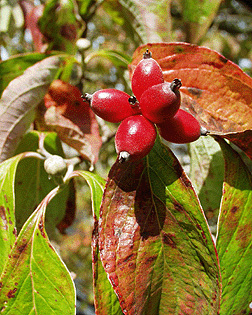
Glossy red dogwood fruit
The flowers, in turn, mature to glossy red fruit clusters that are inedible to humans (some say poisonous), but loved by many species of birds. The bark of mature trees is said to resemble alligator hide. There are now over a hundred cultivated varieties of dogwoods available with white, pink or red flowers; double flowers; variegated leaves; and both dwarf and weeping forms.
Unfortunately, the native tree population has been severely reduced since the late 1970’s by dogwood anthracnose, a lethal fungal disease that has killed 50 percent of the native flowering dogwoods. This disease, known as discula destructiva, spread from trees in the wild to varieties in the home landscape. Dogwoods are also prone to powdery mildew, leaf spot, canker, root rot and leaf and twig blight.
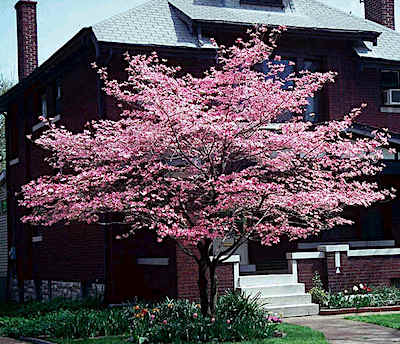
Pink dogwood
However, there are now new varieties of flowering dogwood that are resistant to anthracnose. Most prominent among these is ‘Appalachian Spring,’ developed at the University of Tennessee from a tree discovered in the wild. There are several cultivars available that have white, pink or red bracts. It is also reported to be resistant to powdery mildew.
When considering planting flowering dogwood, first select a disease resistant variety. Next, and perhaps as important, choose a beneficial location and meet the tree’s cultural requirements. While there is some disagreement in the literature about whether or not dogwoods should be grown in full sun or partial shade, two experts in the field, Adrian Higgins and Michael Dirr, recommend planting these trees in partial sun. They should get plenty of light, ideally morning sun, but be protected from the hot afternoon sun.
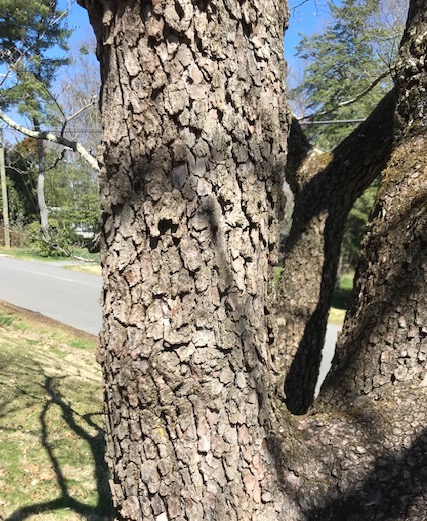
Scaly, blocky mature bark
In the wild, flowering dogwoods naturally grow under the shade of taller trees, often on the edge of the woodland. Good air circulation is important for preventing disease, so some pruning may be necessary to allow for an open branch structure.
Dogwoods do best planted in moist, but not wet, well-drained acidic soils that are organically rich. Young trees need to be protected from drought, so keeping the roots moist and watered during dry periods is important. Adding a 2- to 4-inch (5 to 10 cm) layer of mulch or shredded leaves is beneficial. However, be sure that the mulch does not press up against the soft bark. Keeping dogwoods from becoming stressed, especially when young and not fully established, helps to mitigate disease and insects.
Our neighbors have a very old flowering dogwood in their front yard that I’ve admired for nearly 40 years. It has wonderful character: blocky dark-gray bark, long horizontal branches and is now covered in small “onion-dome” buds waiting to burst in the spring warmth. It does receive morning sun and is planted on a hill, so it is in a well-drained location.
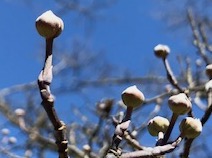
Onion-dome-like dogwood buds
It is so good to know that this tree is making a comeback. Not only is it a beloved symbol of spring, but it has tremendous wildlife value. Birds love the fruit as well as mammals such as chipmunks, foxes, squirrels and deer. The seeds, flowers, twigs, bark and leaves are all used as food by many different animals. Not only is it beautiful, but it will attract wildlife to your garden. Maybe this is the season to plant a dogwood!
References
• Flowering Dogwood, Cornus florida, Virginia Cooperative Extension Publication 3010-1484
• Cornus florida, Missouri Botanical Garden
• Flowering Dogwood, Cornus florida, Bernheim Arboretum and Research Forest
• White Dogwood, Cornus florida, Arbor Day Foundation
• The dogwood tree — the living symbol of the American spring — makes a comeback, Adrian Higgins,
The Washington Post
• Plant of the Week: Pink Dogwood, University of Arkansas Cooperative Extension Service
• Dirr’s Encyclopedia of Trees and Shrubs, by Michael A. Dirr
…updated 2023